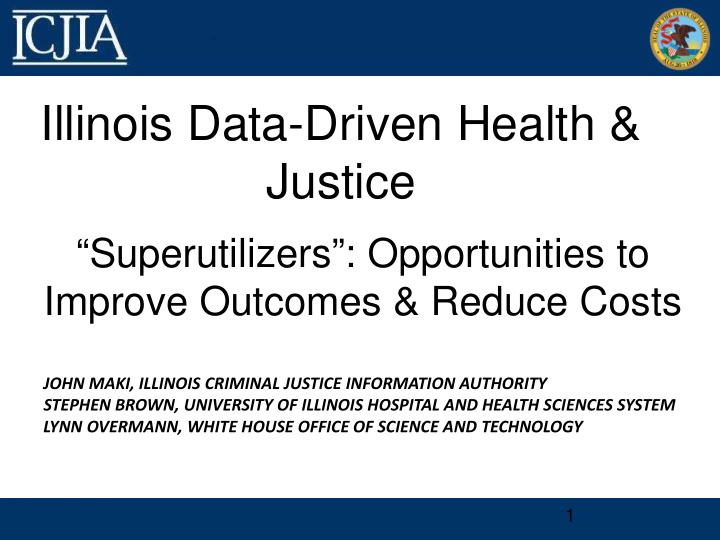



Illinois Data-Driven Health & Justice “Superutilizers”: Opportunities to Improve Outcomes & Reduce Costs JOHN MAKI, ILLINOIS CRIMINAL JUSTICE INFORMATION AUTHORITY STEPHEN BROWN, UNIVERSITY OF ILLINOIS HOSPITAL AND HEALTH SCIENCES SYSTEM LYNN OVERMANN, WHITE HOUSE OFFICE OF SCIENCE AND TECHNOLOGY 1
National Estimates Condition General Jails State Prisons Population Mental Illness 18% 64% 56% Serious Mental Illness 5% 15% (men) 10-25% 31% (women) Drug and/or Alcohol 8% 68% 53% Dependence or Abuse Co-occuring Substance 25% 70% n/a Substance Abuse & Mental Health Disorder 2
Capacity & Consequences Current levels of treatment are insufficient to meet the needs Illinois Department of Corrections substance abuse treatment mirrors national estimates: While IDOC has identified about 80% of inmates with substance abuse/alcohol disorders, it provides treatment to about 30%. Programming is generally more expensive and less effective when administered in a correctional setting Correctional systems often lack evidence-based programming Litigation-Driven Change Results in High Rates of Recidivism/Churning, Difficult Conditions, and Poor Public Safety Outcomes Inmates are at elevated risk of death after they are released, particularly in their first two weeks. 3
Is this the Best We Can Do? The superutilizer should cause us to question Not not just how the criminal justice system can do its job better, but how it can do its job differently Data-driven 360 degree view Reactive and predictive 12/19/2016 | Illinois Criminal Justice Information Authority | 4
SCOUT & SCALE WHAT WORKS: REAL TIME USE OF DATA Camden, NJ Dual-System High Utilizers 205 individuals were identified to be dual-system high utilizers (10+ ED visits & 6+ police encounters over five years). 5
SCOUT & SCALE WHAT WORKS: REAL TIME USE OF DATA Identify Unseen Opportunities to Intervene h 6
SCOUT & SCALE WHAT WORKS: PROACTIVE INTERVENTION, REALIGN EXISTING SERVICES San Diego, CA Project 25: Housing First, Health Home for Serious Mentally Ill and Chronically Homeless In 2010, 28 people cost the community $3.5 million Jail Other 911 Hospital Admissions Arrests ED Visits Total Cost Savings = $3. $3.7 m 7 million over 2 years (n et ROI of 207% in 2012 and • 262% in 2013) All Project 25 individuals housed in their own apartments, have acquired • health care insurance, and are receiving necessary supportive services and care on an ongoing basis. 7
(S OME OF THE ) D ATA C HALLENGES SILOED DATA PRIVACY MANUAL ENTRY A SCALABLE TECH INTEGRATION LEGACY SYSTEMS SOLUITION
Recommend
More recommend